Kiwi fruit is a small, tart, and sweet fruit that might be one of the most delicious fruits you’ll ever taste. It is a highly nutritious food packed with vitamins, minerals, fiber, and antioxidants that help protect your body from damage from free radicals and other environmental pollutants. In addition to their nutritional benefits, kiwis are known for their unique flavor and texture—making them an excellent ingredient in many recipes. This article will provide an overview of what makes kiwifruit tree special and how to incorporate this superfood into your diet.
What is kiwifruit?
The Kiwifruit is small, round-shaped fruit originating from the genus Actinidia of the family Actinidiaceae. Kiwis are native to China and were discovered by Westerners in the early 19th century. The most common type of kiwi is the green variety with brownish-green skin and bright green flesh. In addition to their edible flesh, kiwis have edible seeds encased in a white husk.
History and Origin of Kiwifruit:
Kiwifruit is a native of China and was first discovered by Westerners in the early 19th century. It has since spread to other parts of the world, including New Zealand, where it is now known as “kiwi” after the national bird of New Zealand. The Chinese name for the kiwi fruit is “mihou tao” which translates to “macaque peach.”
Types of Kiwifruit:
Many different types of kiwi fruit are available today, including the classic green variety and yellow, gold, and red varieties. All of these fruits are similar in nutritional value and taste. The most popular type is the classic green kiwi with thin brown skin and bright green flesh inside. Other varieties of kiwi fruit include yellow and gold kiwis, which are sweeter than the classic green variety, and red kiwis, which have a more intense flavor.
Nutritional Benefits of Kiwi Fruit:
Kiwi fruit is an excellent source of vitamins, minerals, and fiber, making it an incredibly nutritious food. It is a good vitamin C, potassium, and dietary fiber source. In addition to their nutrients, kiwis are also rich in powerful antioxidants such as lutein and zeaxanthin, which help protect the body from damage caused by free radicals.
Health Benefits of Kiwi Fruit:
Kiwi fruits are high in antioxidants which help protect your body from environmental pollutants and free radical damage. They are also rich in dietary fibers that can help improve digestive health by reducing constipation. The high levels of vitamin C in kiwis can boost immunity, while potassium helps regulate blood pressure. Additionally, kiwis contain serotonin which can
Nutritional Benefits of Kiwi Fruit:
Kiwi fruit is an excellent source of Vitamin C – providing more than 100% of your daily recommended intake per serving. Vitamin C is an essential nutrient that helps keep your immune system strong, aids collagen production, and helps protect against free radical damage. In addition to vitamin C, kiwis are a good source of potassium, magnesium, dietary fiber, and other compounds that can help support healthy digestion.
Kiwi fruit contains polyphenols – powerful antioxidants linked to various health benefits such as reduced inflammation and improved heart health. One study even found that eating two kiwis a day may help reduce blood pressure levels in people with hypertension.
Kiwi fruit is also a good source of several B vitamins, including thiamine, riboflavin, and folate. These vitamins help your body produce energy from food and support healthy brain function.
Uses of Kiwi fruit:
Kiwi fruit is a popular and nutritious fruit with many uses. It can be eaten raw, cooked, or as an ingredient in various recipes. It’s also used to make smoothies, juices, jams and jellies, ice cream, and desserts. Kiwi fruit can also be used for medicinal purposes. The high levels of vitamin C found in kiwi help boost immunity, protect the heart and reduce inflammation.
Studies have also shown that kiwi may aid digestion, help lower blood sugar levels and even improve sleep quality. Furthermore, kiwi contains powerful antioxidants that can fight off free radicals and help prevent cancerous cell growth.
Finally, its mild flavor is often added to sauces and marinades to give them a unique flavor. Kiwi fruit can also be used in beauty products such as lotions, face masks, and lip balms due to its moisturizing and protective properties. With so many uses, it’s no wonder why kiwi is becoming increasingly popular.
Kiwi is an extremely versatile fruit that can be used for various purposes. It has the potential to be consumed fresh or cooked, added to drinks and desserts prepared at home or bought from stores, and even used medicinally. Its taste is mild yet flavorful, allowing it to blend into any recipe easily. Additionally, kiwi contains numerous vitamins and minerals that benefit our health. All these qualities make kiwi an essential part of a well-balanced diet.
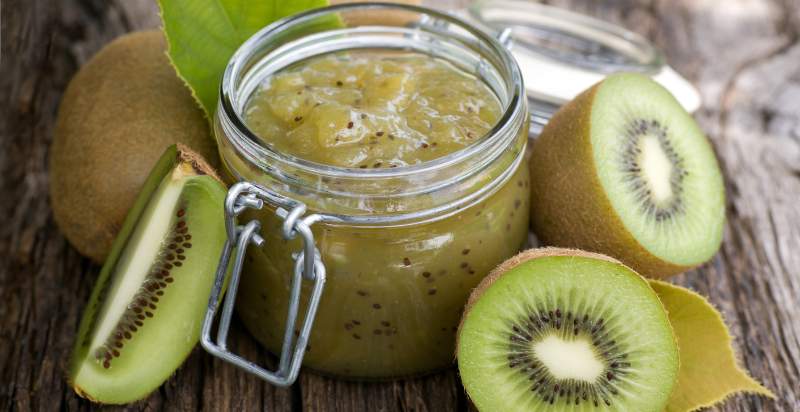
How to Plant Kiwifruit Tree?
Kiwifruit tree can be an incredibly rewarding and tasty addition to any garden. Not only are they delicious, but they are also easy to grow and maintain with just a few basic steps. This guide will provide you with all the information you need to know about how to plant kiwifruit tree in your garden or backyard. We’ll go over the basics of planting kiwis, including what kind of soil is necessary for healthy growth, when is the best time for planting them, and more!
Soil Requirements :
The most important factor for growing a successful crop of kiwi fruits starts with selecting the proper soil type. Kiwis require well-draining soils with plenty of organic matter, and the pH should be slightly acidic, ranging from 5.5 to 7.0. Planting in too alkaline soil can result in poor growth or stunted development of the plants.
Location :
When selecting a location for planting kiwifruit tree, it’s best to choose an area with full sun exposure, as kiwis require plenty of sunlight for optimal growth and fruit production. The area should also have good drainage so that water does not pool around the plant’s roots, which could lead to root rot.
Selection :
Kiwi plants come in both male and female varieties, so it’s important to choose the right combination when selecting your plants. Planting two males will not result in fruit production, so select at least one male and female plant. You can also purchase self-pollinating varieties if you prefer.
Planting Time :
Kiwifruit trees are generally planted during late spring or early summer when temperatures are warmer but cool enough to prevent abrupt shifts in growing conditions. Depending on the variety of kiwi you are planting, the plants may need some protection from extreme temperatures during their first year, so check for any specific precautions that may be necessary for your particular type of kiwi.
Caring for Your Kiwis :
Once planted, it is important to keep the soil moist and provide regular fertilizing throughout the growing season. It’s also important to prune back new growth on your kiwi plants, as this will help promote strong fruit production. Finally, protecting your kiwifruit tree from pests such as aphids and Japanese beetles is essential, which could cause significant damage if left unchecked.
Watering and Fertilizing :
Kiwifruit tree need regular water to grow properly and should be watered whenever the soil dries. During the growing season, fertilization with a balanced fertilizer will help promote strong growth and fruit production. It’s important only to fertilize kiwis that are in active growth as over-fertilization can cause fruit burn or other problems.
Pruning & Training :
The most common way to prune kiwi plants is through tip pruning, which involves removing about two to three inches from all new shoots every spring before they reach full length. This helps keep the plant healthy by promoting increased flowering and fruiting. Kiwis can also be trained along trellises or arbors for easy harvesting and maintenance, although this requires some additional effort from the gardener.
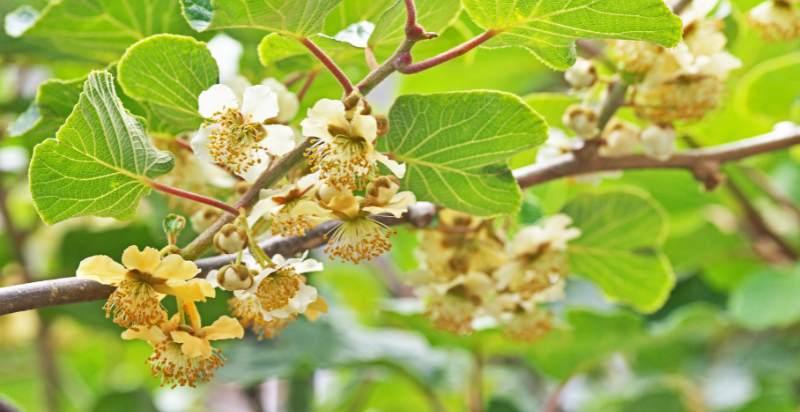
Harvesting :
Kiwi fruits are typically ready to harvest in the late summer or early fall months. To determine if they’re ripe, gently press on the skin, and if it yields to your touch, it’s ready for picking. Allow them to ripen further at room temperature until they become softer before consuming or storing.
With patience and proper care, you can enjoy delicious kiwi fruits right from your home!
Additional Tips on How to care for and Grow kiwi fruits?
Kiwi fruits are a nutrient-rich food packed full of vitamins and minerals. They’re also delicious and can be used in many recipes. But if you want your kiwis to thrive, there are some tips you need to follow for proper care and cultivation.
Climate Requirements :
Kiwifruit tree require temperatures between 50°F (10°C) and 75°F (24°C). In cold climates, it is recommended that the plants be covered with frost protection cloth or brought indoors during colder months. However, it is best to provide some shade for the plants in warm climates when temperatures get too hot.
Soil Conditions :
Kiwifruit tree prefer deep, well-draining soil that is rich in organic matter. The soil pH should be between 6.0 and 7.5 for optimal growth.
Watering and Fertilizing :
Kiwi plants need regular watering, especially during the growing season when they actively produce fruits. They also require fertilizing once every two weeks with a balanced fertilizer to ensure good nutrition and growth.
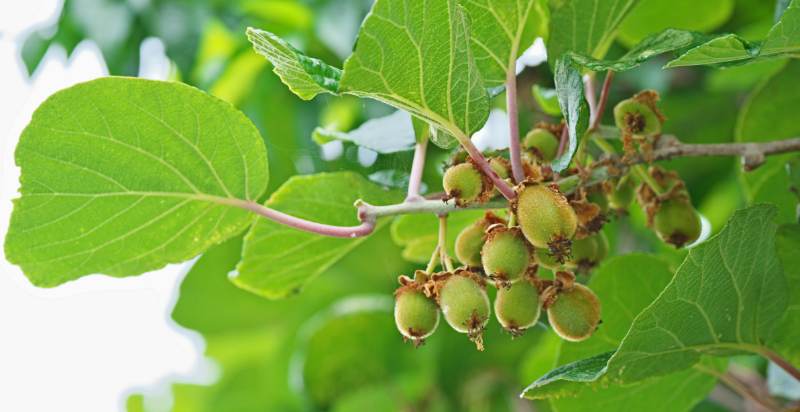
Pruning :
Pruning your kiwi plants encourages fruiting and helps keep them healthy by removing dead or diseased branches and opening up the canopy to allow more light into the plant’s interior. It should be done in late winter or early spring before new growth begins.
Harvesting :
Kiwi fruits are typically ready to be harvested when they turn a deep green shade and give slightly when pressure is applied. The fruit should be picked carefully to avoid damage and not be left on the plant for too long, or it may become overripe.
Additional Tips :
- Plant your kiwifruit tree in an area with partial sun, as full sun can cause excessive foliage growth and inhibit flowering.
- Make sure to plant them far enough apart, so their root systems don’t compete for nutrients or water.
- Remember to cover your kiwi plants with frost protection cloth during cold months if you live in a colder climate.
- When harvesting, use pruning shears or a sharp knife, as pulling the fruit may damage the vine.
- Mulching around your kiwifruit tree is beneficial, as it helps retain soil moisture and prevents weed growth.
- If you notice any signs of disease or pests on your kiwifruit tree, remove them quickly, so they don’t spread to other plants.
- Overall, pay close attention to your kiwifruit tree for the best results. With proper care and cultivation, you can grow healthy and delicious kiwis all year round!
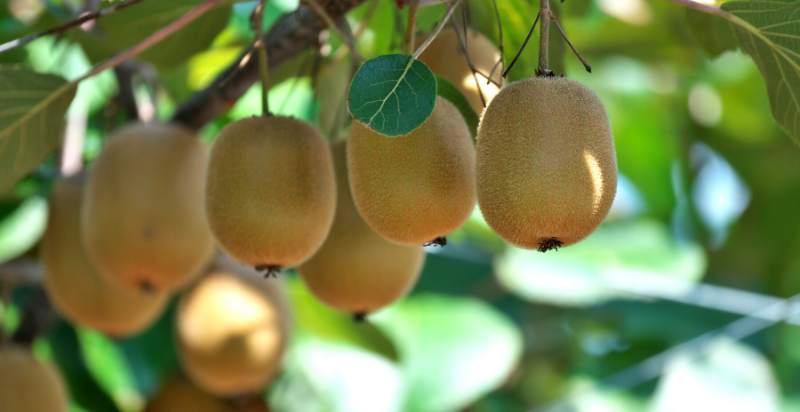
Preventions from Pests And Diseases of Kiwi fruits?
Practicing proper sanitation is the best way to prevent pests from affecting your Kiwi fruit crops. This includes removing any infected plants immediately, regularly inspecting for any signs of infestation, and disposing of damaged or diseased plant parts.
Additionally, make sure to space out plants properly to reduce overcrowding, which can be an ideal environment for pests. It would help if you also used natural controls such as insect traps, bird deterrents, and beneficial insects to help keep your Kiwi fruit crop pest-free.
Prevention from Diseases
It is important to take steps to prevent diseases from affecting your Kiwi fruit crops. Start by choosing resistant varieties of Kiwi fruits, as some are more susceptible to disease than others. It is also important to practice good sanitation, such as cleaning and disinfecting all tools used for pruning or harvesting and removing any diseased plants immediately.
Proper irrigation is also key in preventing diseases, so ensure that you water the plants with adequate amounts of water at regular intervals. Additionally, correctly fertilizing your Kiwi fruit crop can help reduce the risk of disease development.
Following these preventive measures outlined above can help keep your Kiwi fruit crops protected against pests and diseases.
How to Harvest Kiwifruit?
Harvesting kiwis is a rewarding experience that requires patience and knowledge of when the fruit is ripe and ready to be picked. Knowing how to harvest a kiwi correctly can help maximize each plant’s yield while preserving its health and vigor.
When To Harvest Kiwi Fruits?
Kiwis typically ripen in late summer or early fall, depending on where you live. The best way to determine if your kiwi is mature enough to pick is by tasting it! Unripe fruit will taste sour, whereas ripe ones will be much sweeter and juicier. Additionally, if you give the fruit a gentle squeeze, it should be slightly soft. It’s also important to keep an eye out for signs of overripeness—kiwis that are completely soft and browning may have passed their prime.
To Harvest Kiwi Fruits:
When harvesting your kiwis, you should use a pair of sharp pruning shears or scissors to cut them from the vine. Be sure not to pull or twist the fruit too hard; you may damage the stem or even tear off part of the fruit itself! Leave a bit of stem attached since this can help prolong its shelf life. Once your kiwifruit is harvested, store it in the refrigerator for up to two weeks.
Bonus Tip: If you want your kiwifruit to ripen faster, try placing them in a paper bag with a ripe banana or apple overnight! The ethylene gas produced by these fruits will help speed up the ripening process.
Harvesting kiwi fruits can be a fun and rewarding experience. By knowing when to pick the fruit, how to harvest it correctly, and how to store it properly, you’ll be able to enjoy your kiwis for weeks or even months after they’re picked.
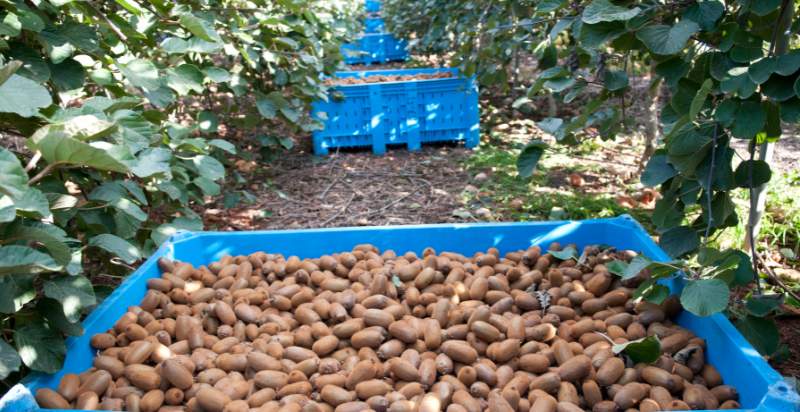
How to Store homegrown kiwifruits?
Homegrown kiwis are especially delightful because they provide the freshest possible taste! But how exactly should you store homegrown kiwi fruits? That’s what we’re going to explore today.
Method One: Refrigeration
The most common way to store homegrown kiwi fruits is to keep them in the refrigerator. Ensure your fridge temperature stays at 40 degrees Fahrenheit or lower; this will help prevent spoilage and encourage optimal ripeness. You can store the kiwis in a perforated plastic bag to help keep them fresh. You should also ensure that the kiwifruit isn’t touching each other; this will prevent damage and bruising.
Method Two: Freezing
You can also freeze homegrown kiwi fruits for up to six months! This is an excellent way to preserve their flavor and texture. To do so, peel the skin off of the fruit and cut it into small chunks before freezing them in an airtight container or freezer bag. Once frozen, thaw out the pieces as you need them and enjoy!
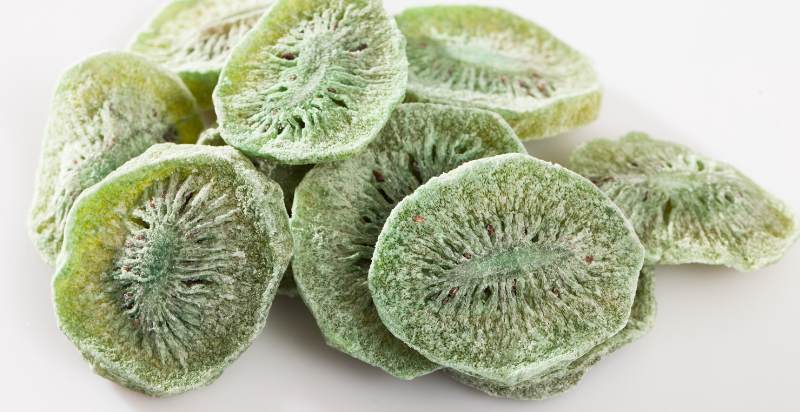
Method Three: Drying
Another option is to dry your homegrown kiwi fruits. Start by peeling the skin off of the fruit and then cutting it into thin slices. Place the slices on a lined baking sheet and bake in your oven at 95 degrees Celsius for four to six hours. Once fully dried, store them in an airtight container or bag until you’re ready to use them.
Sring homegrown kiwifruits are easy! Whether you refrigerate, freeze, or dry them, ensure they are kept in a cool and dry place away from direct sunlight. This will help keep them fresh and delicious for as long as possible! Happy snacking!
How to Use homegrown kiwi fruits in your day-to-day life?
Kiwi fruits are a great addition to any diet, providing tons of vitamins and minerals in a small, juicy package. And because they have such a distinct flavor, homegrown kiwi fruits can be used in countless recipes, from breakfast dishes to desserts. This section will explore how you can incorporate homegrown kiwi fruit into your daily routine and take advantage of its ample health benefits.
Uses for Homegrown Kiwi Fruits:
One way to enjoy homegrown kiwis is by slicing them up and adding them to your favorite salads or sandwiches. The sweet taste will add an extra burst of flavor while also providing essential nutrients like Vitamin C and potassium. You can also use kiwi fruits to make smoothies or fruit juices. Blend a few kiwis with your favorite other fruits and have a delicious, healthy drink you can enjoy any time of day.
Kiwi fruits are also an excellent source of fiber, so adding them to oatmeal or breakfast cereal is another great way to get the most out of your homegrown produce. By incorporating kiwis into your morning routine, you’ll be off to a nutritious start every day.
If you’re looking for delicious desserts, try adding chopped kiwi fruits to cakes, cupcakes, muffins, or pies. You can also use them in frozen treats like ice cream or sorbet. Trust us; you won’t be disappointed with the results!
Finally, homegrown kiwi fruits can also be canned or pickled for long-term storage and future use. This is a great way to ensure that your produce stays fresh and tasty all year round.
No matter how you choose to incorporate homegrown kiwi fruits into your day-to-day life, you can rest assured that they’ll provide plenty of benefits in terms of nutrition and flavor. So don’t hesitate to start experimenting with this delicious fruit today!

Potential Risks from Homegrown Kiwifruits in your day-to-day life:
Homegrown kiwi fruits can contain various harmful bacteria, viruses, fungi, and parasites that can cause food poisoning or other illnesses. The most common health risks of eating homegrown kiwifruit include Salmonella, E.coli, and Listeria monocytogenes. These pathogens can be transferred from contaminated soil or water onto the fruit s skin and then ingested if not washed off properly.
Another potential health risk associated with consuming homegrown kiwi fruits is pesticide exposure. Many chemical pesticides are used on kiwifruit crops to protect them from pests and disease, but these chemicals can be toxic when ingested in high concentrations. To reduce the risk of consuming too many harmful pesticides, it’s important always to buy organic or locally grown kiwifruit that isn’t treated with chemicals.
Other Risks of Eating Homegrown Kiwi Fruits :
In addition to the health risks associated with eating homegrown kiwi fruits, there are also several other potential risks you should be aware of. For instance, some people may have an allergic reaction to kiwi fruits, so it’s important to be aware of any signs or symptoms before eating them.
Finally, there is a risk that homegrown kiwi fruit can become contaminated with other types of foodborne pathogens if they are not properly stored and handled. It’s important always to store the fruit in a cool and dry place, away from other foods that could potentially contaminate it. Additionally, make sure the fruit is washed thoroughly before consuming it.
Eating locally grown organic kiwifruit can provide numerous health benefits while reducing your risk of exposure to harmful bacteria, viruses, and parasites. By following the recommendations outlined in this article, you can enjoy kiwifruit’s delicious flavor and health benefits while minimizing any potential risks.
Conclusion:
Harvesting and using homegrown kiwi fruits is a great way to enjoy this delicious fruit’s sweet and tart flavor all year round. With just a little knowledge, you can easily add homegrown kiwis to your diet in various ways. Just consider any potential risks before consuming kiwis to enjoy your harvest safely!
By following these steps and tips, you’ll be able to reap the benefits of enjoying homegrown kiwi fruits. Enjoy!
- Everything You Wanted to Know About Red Tamarillos - June 2, 2025
- A Guide to Tulips: Everything You Need to Know & More… - June 2, 2025
- Guanabana: Description, Flavor, Benefits, And Uses - May 27, 2025

3 thoughts on “Kiwifruit Tree: Planting, Growing, and Harvesting Kiwifruits ”
Comments are closed.